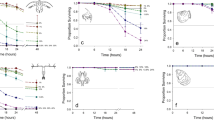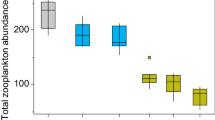Abstract
In acute tests of toxicity, two cladocerans,Daphnia galeata mendotae andCeriodaphnia lacustris, and the calanoid,Diaptomus oregonensis, were more sensitive to fenvalerate thanDaphnia magna, the organism used in standard laboratory bioassays. The 48-hr EC50s for each species/stage in order of increasing sensitivity were adultD. magna — 2.52 μg/L;D. magna (≤48-hr old) — 0.83 μg/L; adultD. galeata mendotae — 0.29 μg/L; adultC. lacustris — 0.21 μg/L;D. galeata mendotae (≤48-hr old) — 0.16 μg/L; adultDiaptomus oregonensis — −0.12 μg/L. No toxicity was observed when these organisms were exposed to a range of concentrations of the emulsifiable concentrate without fenvalerate (the EC blank).
Rates of filtration of the14C-labelled alga,Chlamydomonas reinhardii byD. galeata mendotae, C. lacustris andD. oregonensis were decreased significantly at sublethal concentrations of fenvalerate after only 24-hr exposure.Ceriodaphnia lacustris showed the greatest sensitivity with rates of filtration significantly decreased at 0.01 μg fenvalerate/ L. Concentrations of fenvalerate ≥0.05 μg/L resulted in decreased rates of filtration byD. galeata mendotae. A concentration of 0.10 μg fenvalerate/ L caused rates of filtration to increase inD. oregonensis. whereas 0.05 and 0.5 μg/L resulted in a decrease in these rates.
Rates of assimilation of algae byD. galeata mendotae, C. lacustris andD. oregonensis exposed to similar concentrations of fenvalerate were decreased at concentrations ≥0.05 μg fenvalerate/L. Changes in rates of assimilation were not as sensitive a parameter of toxicity as changes in rates of filtration. The EC blank had no significant effects on rates of filtration or assimilation for all three species.
Similar content being viewed by others
References
Anderson RL (1982) Toxicity of fenvalerate and permethrin to several non-target aquatic invertebrates. Environ Entomol 11:1251–1257
Bogdan KG, McNaught DC (1975) Selective feeding byDiaptomus andDaphnia. Verh Internat Verein Limnol 19:2935–2942
Bradbury SP, Coats JR, McKim JM (1985) Differential toxicity and uptake of two fenvalerate formulations in fathead minnows (Pimephales promelas). Environ Toxicol Chem 4:533–541
Buikema AL, Jr (1973) Filtering rates of the cladoceran,Daphnia pulex as a function of body size, light, and acclimation. Hydrobiologia 41:515–527
Burns CW, Rigler RH (1967) Comparison of filtering rates ofDaphnia rosea in lake water and in suspension of yeast. Limnol Oceanogr 12:492–502
Cooley JM (1977) Filtering rate performance ofDaphnia retrocurva in pulp mill effluent. J Fish Res Board Can 34:863–868
Day KE (1986) The acute, chronic and sublethal effects of the synthetic pyrethroid, fenvalerate, on zooplankton in the laboratory and the field. PhD Thesis, University of Guelph, Guelph, Canada, pp 1–200
Flickinger AL, Bruins RJF, Winner RW, Skillings JH (1982) Filtration and phototaxic behavior as indices of chronic copper stress inDaphnia magna Straus. Arch Environ Contam Toxicol 11:457–463
Fogg GW (1975) Algal cultures and phytoplankton ecology. University of Wisconsin Press, Madison, Wisconsin, pp 1–175
Geiger JG, Buikema AL (1981) Oxygen consumption and filtering rate ofDaphnia pulex after exposure to water-soluble fractions of naphthalene, phenanthrene, No. 2 fuel oil and coal-tar creosote. Bull Environ Contam Toxicol 27:783–789
Goulden CE, Comotto RM, Hendrickson JA, Jr, Hornig L, Johnson KL (1982) Procedures and recommendations for culture and use ofDaphnia in bioassay studies. In: Pearson SG, Foster RB, Bishop WE (eds) Aquatic Toxicology and Hazard Assessment, pp 139–140, ASTM STP 766, Philadelphia, Pennsylvania
Hayward RS, Gallup DN (1976) Feeding, filtering and assimilation inDaphnia schodleri Sars as affected by environmental conditions.Arch Hydrobiol 77:139–163
Heisey D, Porter KG (1977) The effect of ambient oxygen concentration on filtering and respiration rats ofDaphnia galeata mendotae andDaphnia magna. Limnol Oceanogr 22:839–845
Kersting K (1983) Direct determination of the “threshold food concentration” forDaphnia magna. Arch Hydrobiol 96:510–514
Kersting K, van der Honing H (1981) Effect of the herbicide dichlobenil on the feeding and filtering rate ofDaphnia magna. Verh Internat Verein Limnol 21:1135–1140
Khan NY (1983) An assessment of the hazard of synthetic pyrethroid insecticides to fish and fish habitats. In: Miyamoto J, Kearney PC (eds), Pesticide chemistry: Human welfare and the environment. Mode of action, metabolism and toxicology. Vol. 3, Pergamon Press, Oxford, pp 436–450
Lampert W (1977a) Studies on the carbon balance ofDaphnia pulex DeGeer as related to environmental conditions. I. Methodological problems of the use of14C for the measurements of carbon assimilation. Arch Hydrobiol (Suppl) 48:287–309
— (1977b) Studies on the carbon balance ofDaphnia pulex DeGeer as related to environmental conditions. IV. Determination of the “threshold” concentration as a factor controlling the abundance of zooplankton species. Arch Hydrobiol (Suppl) 48:361–368
Lawrence SG (1981) Manual for the culture of selected freshwater invertebrates. Can Spec Pub Fish Aquat Sci 54, Dept of Fish and Oceans, pp 31–50
McKenney CL, Hamaker DB (1984) Effects of fenvalerate on larval development ofPalaemonetes pugio (Halthuis) and on larval metabolism during osmotic stress. Aquat Toxicol 5:343–355
McLeese DW, Metcalfe CD, Zitko V (1980) Lethality of permethrin, cypermethrin and fenvalerate to salmon, lobster and shrimp. Bull Environ Contam Toxicol 25:950–955
McQueen DJ (1970) Grazing rates and food selection inDiaptomus oregonensis (Copepoda) from Marion Lake, B.C. J Fish Res Board Can 27:13–20
Miller TA, Adams ME (1982) Mode of action of pyrethroids. In: Coats JR (ed), Insecticide Mode of Action, pp 3–27, Academic Press, New York pp 3–27
Narahashi T (1983) Nerve membrane sodium channels as the major site of pyrethroids and DDT. In: Miyamoto J, Kearney PC (eds), Pesticide Chemistry: Human welfare and the environment. Vol. 3. Mode of action, metabolism and toxicity, Pergamon Press, Oxford, pp 109–144
Nichols HW (1973). I. Growth media-freshwater. In: Stein JR (ed) Handbook of Phycological Methods. Culture Methods and Growth Measurements, Cambridge Univ Press, Cambridge, pp 7–24
O'Brien WJ, DeNoyelles F, Jr (1974). Filtering rate ofCeriodaphnia reticulata in pond waters of varying phytoplankton concentrations. Am Midl Nat 91:509–512
Pennak RW (1978) Freshwater Invertebrates of the United States. John Wiley and Sons, New York, pp 1–803
Peters RH (1984) Methods for the study of feeding, grazing and assimilation by zooplankton. In: Downing JH, Rigler FH (eds) A Manual on Methods for the Assessment of Secondary Productivity in Fresh Waters, IBP Handbook 17, 2nd edition, Blackwell, London
Peters RH, Downing JA (1984) Empirical analysis of zooplankton filtering and feeding rates. Limnol Oceanogr 29:763–784
Pimentel D, Edwards CA (1976) Pesticides and ecosystems. Bioscience 32:595–600
Porter KG, Gerritsen J, Orcutt JD, Jr (1982) The effect of food concentration on swimming patterns, feeding behavior, ingestion, assimilation and respiration byDaphnia. Limnol Oceanogr 27:935–949
Richman S (1958) The transformation of energy byDaphnia pulex. Ecol Monogr 28:273–291
— (1966) The effect of phytoplankton concentration on feeding rate ofDiaptomus oregonensis. Verb Internat Verein Limnol 16:392–398
Rigler FH (1971) Laboratory measurements of processes involved in secondary production. Feeding rates-zooplankton. In: Edmondson WT, Winberg, GG (eds) A Manual on Methods for the Assessment of Secondary Productivity in Freshwater, IBP HB17, Blackwell, Oxford, pp 228–256
Schindler DW (1968) Feeding, assimilation and respiration rates ofDaphnia magna under various environmental conditions and their relation to production estimates. J Anim Ecol 37:369–385
Sorokin JI (1966) Carbon-14 method in the study of the nutrition of aquatic animals. Int Revue ges Hydrobiol 51:209–224
Sprague JB (1976) Current status of sublethal tests of pollutants on aquatic organisms. J Fish Res Board Can 33:1988–1992
Steel RGD, Torrie JH (1960) Principles and procedures of statistics. A biometrical approach. McGraw-Hill, New York
Stephenson RR (1982) Aquatic toxicology of cypermethrin. I. Acute toxicity to some freshwater fish and invertebrates in laboratory tests. Aquat Toxicol 2:175–185
Stratton GW, Corke CT (1981) Interaction of permethrin withDaphnia magna in the presence and absence of particulate material. Environ Pollut (Series A) 24:134–144
Ullrich SO, Jr, Millemann RE (1983) Survival, respiration and food assimilation ofDaphnia magna exposed to petroleum and coal-derived oils at three temperatures. Can J Fish Aquat Sci 40:17–26
Author information
Authors and Affiliations
Rights and permissions
About this article
Cite this article
Day, K., Kaushik, N.K. Short-term exposure of zooplankton to the synthetic pyrethroid, fenvalerate, and its effects on rates of filtration and assimilation of the alga,Chlamydomonas reinhardii . Arch. Environ. Contam. Toxicol. 16, 423–432 (1987). https://doi.org/10.1007/BF01055263
Received:
Revised:
Issue Date:
DOI: https://doi.org/10.1007/BF01055263




